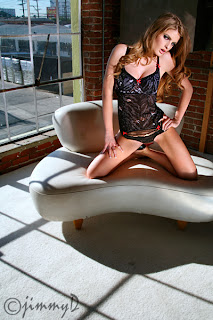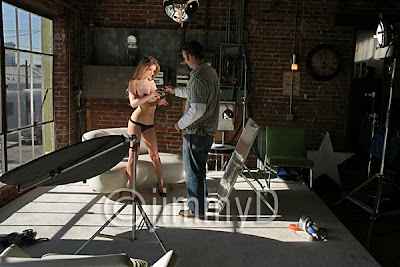 It's refreshing to encounter shooting situations where I get opportunities to venture outside my usual, pretty-girl-shooting, cookie-cutter, safe zone. This past Thursday was just such a day. Leastwise, my first set in the A.M. went down that way.
It's refreshing to encounter shooting situations where I get opportunities to venture outside my usual, pretty-girl-shooting, cookie-cutter, safe zone. This past Thursday was just such a day. Leastwise, my first set in the A.M. went down that way.I was booked to provide photo coverage for a video shoot at a loft studio in downtown L.A. This means I would shoot the
The loft studio was cool. It was on the second floor of an aging brick building near the Boyle Heights area of Los Angeles. (Not the kind of place you'd want to go out alone for an evening stroll.)
When I arrived, my first
I decided--since they told me I could shoot pretty much anywhere in the studio as long as I didn't interfere with the video shooting--I'd do my first set next to some windows where the morning light was intensely shining through. Apparently, Faye was going to be the covergirl on the DVD's front cover and the director wanted some pics of her that were a little more on the dramatic side.
The windows frames were casting some really cool shadows on the white-carpeted floor and I thought it would make for some interesting images. I knew I could equal or overpower the sunlight with my strobes but I didn't have much with me to control my lights: No grids, doors, flags,or any of that stuff. (I try to travel as light as I can... which still fills my trunk and back seat with gear.) I didn't want to blow out the shadows and, instead, wanted to light the model separated from the rest of the shooting environment, leaving the rest of the set the way the sun was lighting it. In other words, because of what the images would be used for I needed to brightly pop the model but in a very directed and controlled way-- isolated from the rest of the image. (i.e., I couldn't shoot her semi-hidden in shadow nor did I want to blow out those shadows.)
The video's gaffer, Joel, and a lighting grip were setting up nearby. "Dude!" I shouted. "You have any HMI's with you?"
"Yeah," he said. "I have a couple of 1200 PARs in the van." (1200 = 1.2K and PAR = Parabolic Aluminized Reflector.) "I was just about to bring them in." he added.
"Cool!" I beamed. "Could I use one?"
Joel agreed and said he'd assist for me if I wanted. I'm rarely one to turn down some offered help.
BTW, for those who aren't familiar with them, HMIs are powerful, daylight-balanced, continuous lighting instruments. The "H" is for Hg, the symbol for the chemical element, mercury, the M stands for medium arc, and the "I" is for iodides. In other words, an HMI is a focusable arc light (focused by using various lenses) producing intense and continuous daylight-balanced light.
The MUA was just putting the finishing touches on Faye as Joel started setting up the HMI where I asked him to put it. For most of the stuff I shoot (on video sets, that is) I usually get about a half-hour with the model. That's 30 minutes from the time the model gets up out of the makeup chair and when I need to click my last exposure. I usually have the lights semi-set where I want them and I start taking meter readings once the model is mine and standing where I need her to be.
Joel had the HMI where I wanted it. He also brought a medium shiny board for some fill. I pulled out my 5-in-1 Westcott reflector and used it, with the silver-side out, for some additional fill. In the image below, Joel is

The clock was ticking for my time with Faye and the PM (Production Manager) was already impatiently asking me why I wasn't shooting yet. I started taking meter readings while Joel assisted, focusing the HMI and aiming and diddling with the shiny board and the reflector to get the light where I wanted it as well as the the exposure I was looking for. What made it even more difficult was the fact that, between the shiny board and the HMI, the light on the model was very bright and intense. For almost every capture, I had to count to three and, on "three," the model would open her eyes. I'd then click the shutter and, almost immediately, Faye would close her eyes again.
Everyone that counts (the client, the director, the PM, the model, and Joel and I) were happy with the results. I was especially happy for the opportunity to shoot something outside my usual comfort zone. And, by the end of the day, the world could rest easier: Another porn masterpiece was in the can--with accompanying photo documentation--and I get to stay off the dole for another week or two.
Here's another of Faye. I'm happy to say that anyone familiar with my work would probably not recognize these images--whether they like them or think they suck--as the work of JimmyD, a.k.a. the Pretty Girl Shooter.


7 comments:
I don't have any HMI's. In that situation, I wonder if my two Nikon SB-800's with snoots (Strobist dude here) would have produced enough hard light to counter the window daylight.
Carlton-- Most photographers don't own HMIs. I sure don't. That particular 1200 PAR is about $3,000. Add a variety of lenses and a junior stand to mount it on and you're looking at close to four grand!
I think you might be able to accomplish this shot, Strobist-style, with your SB-800s. You'd certainly need both of them... tightly controlled. Not sure if a snoot would work as you'd need the strobes in close and the snoot might over-control the light. Obviously, moving the snooted strobes back would weaken the intensity of the light reaching the model. Perhaps some black foil, cleverly shaped, would allow you to keep the strobes in close yet allowing more of a spread to the light?
The "daylight balanced" statement has me intrigued. I'm just starting to get seriously in this type of photography and I obviously have a lot to learn. If I may ask, when something is daylight balanced, what does it mean in relation to other types of lighting?
Also, on a side note, are her eyebrows really like that? Is that a part of the theme of the shoot or the MUA's choice?
You rock dude...
Chris--
Daylight balanced = Daylight Color Temperature, i.e,. white balance is for daylight.
For the most part, the two color temperatures we most often deal with are Tungsten and Daylight.
Eyebrows were MUAs deal altho the video's director probly instructed the MUA to apply her make-up slightly to the fetishy side.
Wow! Gorgeous expression! Very "come hither" eyes :-)
I thought that HMI stood for "extremely expensive continuous lighting that ordinary photographers can't afford", at least not from the prices that I've seen. Seriously, I understand that HMIs are a version of the Metal Halide high output lamps that are used in commercial lighting. I've got a couple of 400 Watt metal halide lamps and some ballasts that I intend to try in some 2K stage lights (Fresnels), but haven't had the time to do it. The main drawback to these lamps is warm up time and lack of intensity control.
Actually the H in HMI is for Hydragarium which is an old name for Mercury.
Nice stuff, great to see you take advantage of the situation.
Post a Comment